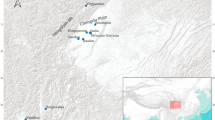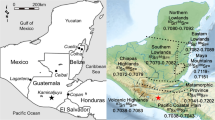Abstract
The Erlitou site is located at Yanshi City, Henan Province. This site is a large settlement site of Erlitou culture, and it is dated to 3800–3500 a BP. Five kinds of domestic animals, i.e., dogs, pigs, sheep, goats, and cattle were found from the site. In this paper, two problems have emerged in studies involving the estimation of local isotope levels and the distinction of migrants from locals. Tooth enamel samples from 17 domestic animals individuals were analyzed for strontium isotope ratio (87Sr/86Sr), by the thermal ionization mass spectrometry, including 10 pigs, 5 sheep and 2 cattle. The results show that the mean 87Sr/86Sr ratios of 10 pigs enamel samples were 0.712078, Based on the local strontium isotopes ratio range determined by the mean 87Sr/86Sr ratios ±2σ of 10 pig enamel samples (0.712256–0.711900), we found that five sheep and one cattle from the Erlitou site fell well outside the local strontium isotopes ratio range and were considered to be non-local.
Similar content being viewed by others
References
Towers J, Montgomery J, Evans J, et al. An investigation of the origins of cattle and aurochs deposited in the early Bronze Age barrows at Gayhurst and Irthlingborough. J Arch Sci, 2010, 37: 508–515
Copeland S R, Sponheimer M, Lee-Thorp J A, et al. Strontium isotope ratios in fossil teeth from South Africa: Assessing laser ablation MC-ICP-MS analysis and the extent of digenesis. J Arch Sci, 2010, 37: 1437–1446
Kennedy B P, Folt C L, Blum J D, et al. Natural isotope markers in salmon. Nature, 1997, 387: 766–767
Blum J D, Taliaferro E H, Weisse M T, et al. Changes in Sr/Ca, Ba/Ca and 87Sr/86Sr ratios between two forest ecosystems in the northeastern USA. Biogeochemistry, 2000, 49: 87–101
Aberg G. The use of natural strontium isotopes as tracers in environmental studies. Water Air Soil Pollut, 1995, 79: 309–322
Ericson J E. Strontium isotope characterization in the study of prehistoric human ecology. J Human Evolut, 1985, 14: 503–514
Bentley R A. Strontium isotopes from the earth to the archaeological skeleton: A review. J Arch Method Theory, 2006, 13: 135–187
Sealy J C, Van Der Merwe N J, Sillen A, et al. 87Sr/86Sr as a dietary indicator in modern and archaeological bone. J Arch Sci, 1991, 18: 399–416
Price T D, Johnson C M, Ezzo J A, et al. Residential mobility in the prehistoric Southwest United States: A preliminary study using strontium isotope analysis. J Arch Sci, 1994, 14: 503–514
Sealy J C, Armstrong R, Schrire C. Beyond lifetime averages: Tracing life histories through isotopic analysis of different calcified tissues from archaeological human skeletons. Antiquity, 1995, 69: 290–300
Evans J, Chenery C A, Fitzpatrick A P. Bronze age childhood migration of individuals near stonehenge, revealed by strontium and oxygen isotope tooth Enamel analysis. Archaeometry, 2006, 48: 309–321
Haverkort, C M, Weber A, Katzenberg M A, et al. Hunter-gatherer mobility strategies and resource use based on strontium isotope (87Sr/86Sr) analysis: A case study from Middle Holocene Lake Baikal, Siberia. J Arch Sci, 2008, 35: 1265–1280
Nehlich O, Montgomery J, Evans J, et al. Mobility or migration: A case study from the Neolithic settlement of Nieder-Mörlen (Hessen, Germany). J Arch Sci, 2009, 36: 1791–1799
Price T D and Gestsdóttir H. The first settlers of Iceland: An isotopic approach to colonization. Antiquity, 2006, 80: 130–144
Grupe G, Price T D, Schroter P, et al. Mobility of Bell Beaker people revealed by strontium isotope ratios of tooth and bone: A Study of southern Bavarian skeletal remains. Appl Geochem, 1997, 12: 517–525
Price T D, Johnson C M, Ezzo J A, et al. Residential mobility in the prehistoric Southwest United States: A preliminary study using strontium isotope analysis. J Arch Sci, 1994, 14: 503–514
Montgomery J, Budd P, Evans J. Reconstructing the lifetime movements of ancient people: A Neolithic case study from Southern England. Euro J Arch, 2000, 3: 370–385
Bentley R A, Buckley H R, Spriggs M, et al. Lapita migrants in the Pacific’s oldest cemetery: Isotope analysis at Teouma, Vanuatu. Am Antiquity, 2007, 72: 645–656
Balasse M, Ambrose S H, Smith A B. The seasonal mobility model for prehistoric herders in the south-western cape of South Africa assessed by isotopic analysis of sheep tooth enamel. J Arch Sci, 2002, 29: 917–932
Hoppe K A. Late Pleistocene mammoth herd structure, migration patterns, and Clovis hunting strategies inferred from isotopic analyses of multiple death assemblages. Paleobiology, 2004, 30: 129–145
Hedman K M, Curry B B, Thomas M, et al. Variation in strontium isotope ratios of archaeological fauna in the Midwestern United States: A preliminary study. J Arch Sci, 2009, 36: 64–73
Britton K, Grimes V, Dau J. Reconstructing faunal migration using intra-tooth sampling and strontium and oxygen isotope analyses: A case study of modern caribou (Rangifer tarandus granti). J Arch Sci, 2009, 36: 1163–1172
Yin R C, Zhang J Z, Yang X Y. Preliminary study of prehistoric human migration based on Sr isotope analysis from Jiahu relics (in Chinese). Quat Sci, 2008, 28: 50–57
Xu H. The Earliest Chinese (in Chinese), Beijing: Science Press, 2009. 14–18
Yang J. The Remains of Animals Unearthed from Erlitou site, Early Chinese Bronze Culture—Erlitou Culture (in Chinese). Beijing: Science Press, 2008. 470–539
Viner S, Evans J, Albarella U, et al. Cattle mobility in prehistoric Britain: Strontium isotope analysis of cattle teeth from Durrington Walls (Wiltshire, Britain). J Arch Sci, 2010, 37: 2812–2820
Grupe G, Price T D, Schroter P, et al. Mobility of Bell Beaker people revealed by strontium isotope ratios of tooth and bone: A study of southern Bavarian skeletal remains. Appl Geochem, 1997, 12: 517–525
Price T D, Manzanilla L, Middleton W D. Immigration and the ancient city of Teotihuacán in Mexico: A study using strontium isotope ratios in human bone and teeth. J Arch Sci, 2000, 27: 903–913
Price T D, Burton J H, Bentley R A. The characterization of biologically-available strontium isotope ratios for investigation of prehistoric migration. Archaeometry, 2002, 44: 117–135
Sillen A, Hall G. Armstrong R. 87Sr/86Sr ratio in modern and fossil food-webs in sterkfontein valley: Implications for early hominid habitat preference. Geochim Cosmochim Acta, 1998, 62: 2463–2473
Bentley R A, Price T D, Stephan E. Determining the “local” 87Sr/86Sr rang for Archaeological skeletons: A case study from Neolithic Europe. J Arch Sci, 2004, 31: 365–375
Julia I D. Strontium isotope analysis of Neolithic and Copper age population on the Great Hungarian Plain. J Arch Sci, 2009, 36: 491–497
Knudson K J, Tung T A, Nystrum K C, et al. The origin of the Juch’uypampa cave mummies: Strontium isotope analysis of archaeo-logical human remains from Bolivia. J Arch Sci, 2005, 32: 903–913
Bentley R A, Buckley H R, Spriggs M, et al. Lapita migrants in the Pacific’s oldest cemetery: Isotope analysis at Teouma, Vanuatu. Am Antiquity, 2007, 72: 645–656
Hedman K M, Curry B B, Johnson T M, et al. Variation in strontium isotope ratios of Archaeological fauna in the Midwestern United States: A preliminary study. J Arch Sci, 2009, 36: 64–73
Yuan J, Flad R K. Pig domestication in ancient China, Antiquity, 2002, 76: 724–732
Yuan J. Zooarchaeological study on the domestic animals in ancient China (in Chinese). Quat Sci. 2010, 30: 298–306
Luo Y B, Zhang J Z. Restudies of pig bone from Jiahu site (in Chinese). Archaeology, 2008, 1: 91–95
Author information
Authors and Affiliations
Corresponding author
Rights and permissions
About this article
Cite this article
Zhao, C., Yang, J., Yuan, J. et al. Strontium isotope analysis of archaeological fauna at the Erlitou site. Sci. China Earth Sci. 55, 1255–1259 (2012). https://doi.org/10.1007/s11430-012-4400-9
Received:
Accepted:
Published:
Issue Date:
DOI: https://doi.org/10.1007/s11430-012-4400-9




